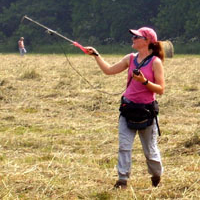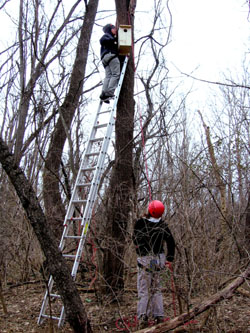Quicksilver
 From 1929-1950 liquid mercury leaked into the South River as it
meandered through an industrial section of Waynesboro, near
Charlottesville, Virginia.
From 1929-1950 liquid mercury leaked into the South River as it
meandered through an industrial section of Waynesboro, near
Charlottesville, Virginia.
It wasn't until 1977 that the problem came to light, and this once famous small-mouthed bass fishing paradise was closed to human fish consumers. But liquid mercury, once it sinks into the river bottom, doesn't go away willingly. While humans can read the warning posters and avoid eating the toxic fish, herons and otters don't have that option.
Since 2005, Associate Professor of Biology and ENSP affiliate Dan Cristol has been assessing the effects of mercury contamination on birds in the Shenandoah Valley with an army of master's and undergraduate researchers. The William and Mary group works with the South River Science Team, an association of academic, industry and government researchers examining all aspects of the lingering mercury legacy in the South River. For several years the science team has been examining soil, water, fish and invertebrates to better understand the mercury problem. Cristol's team is the first to examine mercury levels in the region's birds.
In 2005, undergraduates Ravi Jefferson-George and Sean Koebley joined master's candidates Rebecka Brasso and Ariel White (who both recently received their degrees). Living together with Professor Cristol in a crowded ski cabin atop Massanuttan, they enticed a tree swallow population to breed along the South and Shenandoah rivers by setting up over 200 nest boxes. They monitored the success of the resulting nests and took tiny blood and feather samples to determine mercury loads. Because swallows eat insects that have grown up in the rivers' contaminated sediments, they are an excellent "biomonitor" for the effects of mercury on birds.
 After achieving varying levels of boating skills, the crew located and
sampled the existing population of belted kingfishers. Kingfishers eat
nothing but fish and would be expected to bear the full brunt of
mercury contamination. Both of these efforts found greatly elevated
mercury levels in the birds eating from the river, but the biggest
surprise was when the effort turned to the land. Forest birds living
along the river, such as wrens, vireos and flycatchers, had mercury
levels as high or higher than swallows and kingfishers.
After achieving varying levels of boating skills, the crew located and
sampled the existing population of belted kingfishers. Kingfishers eat
nothing but fish and would be expected to bear the full brunt of
mercury contamination. Both of these efforts found greatly elevated
mercury levels in the birds eating from the river, but the biggest
surprise was when the effort turned to the land. Forest birds living
along the river, such as wrens, vireos and flycatchers, had mercury
levels as high or higher than swallows and kingfishers.
In the summer of 2006, master's students Anne Condon and Scott Friedman joined the effort, along with undergraduates Kelly Hallinger, Rachel Fovargue, Jack Reese and Adrian Monroe, and Thomas Nelson Community College intern Maryse Leandre. Living in a chaotic townhouse in Fisherville, and joined in the field sporadically by colleagues from the Virginia Institute of Marine Science and Virginia Tech, the now seasoned crew amassed the biggest data set on mercury contamination in birds ever gathered. Sampling of over 30 species of forest birds, as well as huge numbers of kingfishers, mallard ducks, screech owls and swallows, revealed the first known case of mercury leaving a contaminated river and entering the terrestrial food chain. Because no one has ever looked before, it's not certain yet whether this phenomenon occurs at many other of the 2000 mercury-contaminated rivers in the U.S.
In addition to the core research, funded generously by grants from DuPont and NSF, most of the students developed independent research projects. For example, Anne Condon followed bluebirds after they left their nests, using miniaturized radio-tracking devices, and found that once their baby feathers stop growing, mercury levels rise dramatically. Scott Friedman mastered a safe but disgusting technique to pull food items out of the throats of baby forest birds. He then ran his collection of hundreds of spiders, bugs and caterpillars through a mercury analyzer, and is constructing a mathematical model to determine if differences in diet can explain mercury levels.
Kelly Hallinger recorded the songs of advertising male birds from contaminated and reference sites, and with Dan Zabransky and Katie Kazmer is using sound analysis software to determine whether mercury, a known neurotoxin, causes males to sing weaker songs. Adrian Monroe followed up on our discovery that tree swallows were commonly nesting a second time on our study sites, something that these migratory birds are not supposed to do. Rachel Fovargue is pursuing her interest in mercury to museum collections, where she will sample feathers from century-old specimens to look at historical trends in mercury pollution.
Besides the fact that the quicksilver will still be coursing through the avian food web of the Shenandoah Valley, there's no predicting what will be discovered in 2007.
 Skip to main content
Skip to main content
